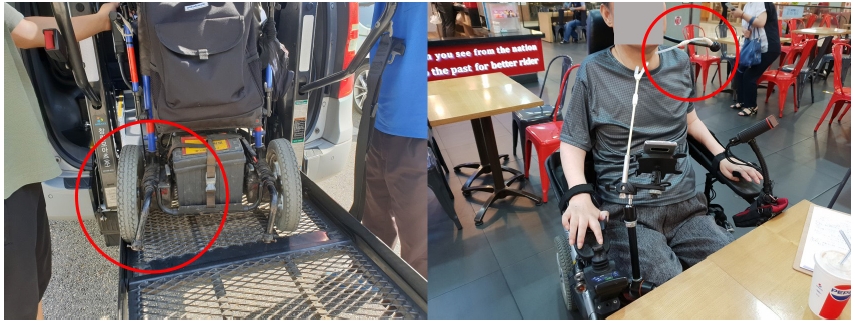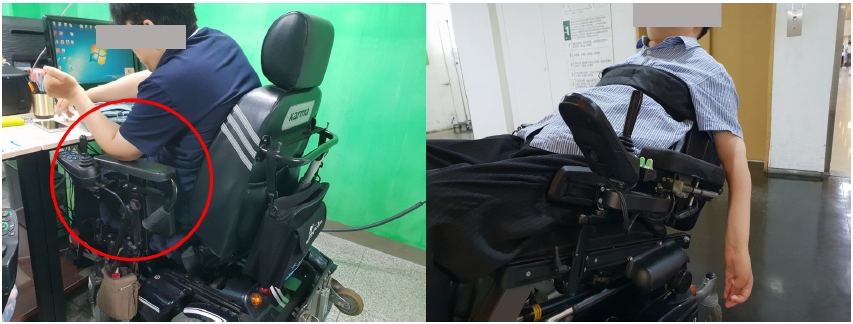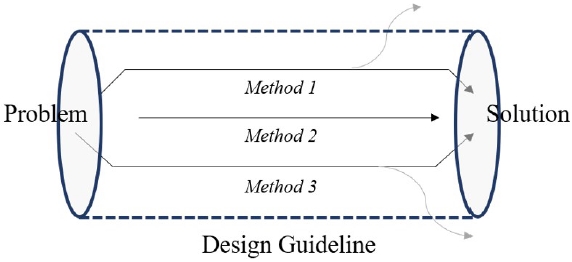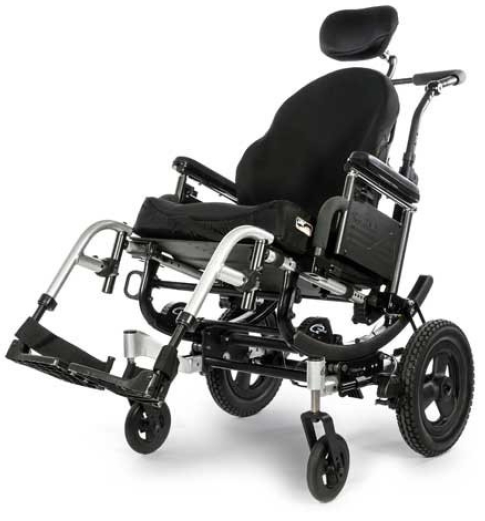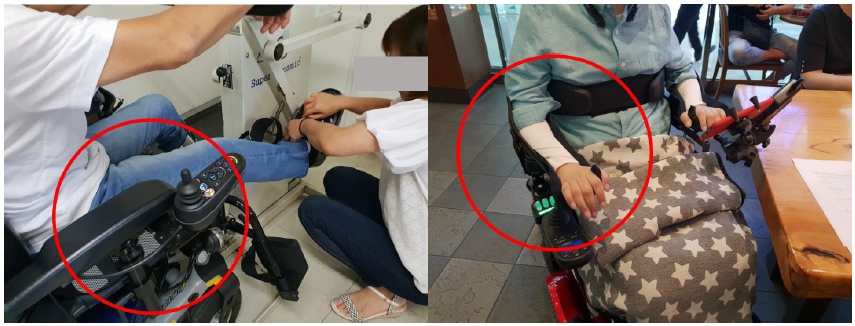
Usability of Assistive Technology: User Interface Design Guidelines for Powered Wheelchairs
Background The usability of assistive devices indicates the users’ level of participation in various roles. Powered wheelchairs allow users with severe disabilities to operate wheelchairs using their remaining functions, because of which, the user interface of a powered wheelchair is as complex and varied as the degree of user disability. However, compared to manual wheelchairs, types of powered wheelchairs that can reflect the needs of individual users are limited.
Methods User research was conducted on 15 people with high-level spinal cord injuries. The results of the user research were analyzed using the thematic analysis method. Based on the analysis results, user interface design guidelines were developed to ensure the usability of powered wheelchairs. In addition, these guidelines were verified by five assistive technology and wheelchair experts.
Results Thematic analysis resulted in five themes: wheel movements, use controller, component adjustments, sitting posture adjustments, and physical characteristics. User interface design guidelines for powered wheelchair components such as wheels, controllers, power seat functions (PSFs), and armrests are derived according to the various usage characteristics of powered wheelchairs.
Conclusions It is expected that products developed based on the guidelines derived from this study will minimize the heterogeneity of development and consumer choice. The results of this study deal only with the initial stages of user interface design (use and user interface design specification). Therefore, further research is needed to address the later stages of user interface design (formative and summative evaluation).
Keywords:
User Research, User Interface Design Guidelines, Usability, Powered Wheelchair, People with Spinal Cord Injuries1. Introduction
If people could have one superpower, most would say that they would like to have the power of teleportation. This shows the importance of mobility. Studies of measuring usability of assistive technology (AT) show the importance of mobility in humans. Human mobility is inherently central to well-being and occupational performance, and evaluating and optimizing the usability of a wheelchair has direct implications on user participation (Arthanat et al., 2009). Although user interface and usability are important factors in the use of a wheelchair, Mónica et al. (2013) claim that many intelligent wheelchair prototypes are being developed in research projects worldwide but the adaptation of their user interface to the individual characteristics of their users is often neglected.
It has previously been observed that most studies on usability of powered wheelchairs conducted by clinical experts focused mainly on usability evaluation and measurement (Wessels et al., 2002; Scherer & Glueckauf, 2005; Demers et al., 2002; Jutai & Day, 2002). However, wheelchair designers and developers need a study that explores “how” users interact with wheelchairs in order to make improvements to wheelchair design.
This study uses qualitative analysis in order to gain insights into design implications. Arthanat et al. (2009) qualitatively investigated powered wheelchair usability reflecting on the usage environment. Evaluating the usability of wheelchairs using the Usability Scale for Assistive Technology (USAT) tool will yield results related to “what” and “who”, and will thereby inform matters such as usability issues (wheelchair use, reported problems, intervention possibility, and stakeholders). However, the present study differs from previous studies insofar as it explains how users interact with wheelchairs, assistive devices, caregivers, and the environment by focusing on the contexts of these interactions. Furthermore, the phrase “user interface of powered wheelchair” will be used in this study to describe the powered wheelchair components that affect its usability and interact with the user. Not only controllers such as joysticks, but components that affect usability are considered as user interfaces.
This study investigates how people with spinal cord injuries interact with their powered wheelchairs and what use requirements the users have from their powered wheelchairs in their real life environments. Based on the study results, the authors have established design guidelines for powered wheelchair user interface for people with spinal cord injuries.
2. Methods
User research was conducted on 15 subjects with high-level spinal cord injuries. Based on the results of the user research (taking into consideration user characteristics and use requirements by usage status of powered wheelchair user interface), user interface guidelines were created to guarantee the usability of each powered wheelchair user interface element. Five experts in AT and wheelchairs verified the guidelines. This research protocol has been reviewed and approved by the Institutional Review Board of University (Approval number: 1041849-201805-SB-046-01).
2. 1. Subjects
The participants were divided into three groups based on their powered wheelchair controller type: basic controller users, modified controller users, and special controller users. Basic controller such as a joystick is a controller that is provided by a powered wheelchair manufacturer. A special controller such as a sip and puff controller, head controller, or chin controller is a controller that is provided by a power wheelchair manufacturer for users with limited hand movements. A modified controller refers to a controller that has been modified by a user, who does not have enough hand coordination to use the basic controller for his/her convenience. It is expected that this study will provide guidelines for how to design user interface for each user group by examining the similarities and differences among each groups’ user characteristics, user interface usage status, and use requirements.
The number of subjects was determined to be five people per group (a total of 15 subjects). According to “Measuring the User Experience” (Albert & Tullis, 2013), five participants will reveal about 80 percent of usability issues and the authors claim that each participant will reveal about 30 percent of usability problems. Thus, five different users per group are sufficient to identify the most important usability issues.
The reaserchers asked the Korea Spinal Cord Injury Association to cooperate with subject recruitment, explaining the research directly to the subjects and then proceeding with the recruitment.
2. 2. User Research
Interview items were categorized according to whether they were related to user characteristics, wheelchair characteristics, main social activities, or the environment. Each interview item was designed based on the Human Activity Assistive Technology (HAAT) model and the Matching Person and Technology (MPT) model. According to Arthanat et al. (2007), these models imply that the concept of AT usability should include a holistic understanding of the relationship between users, assistive technologies, activities, and the environment.
The method of shadowing was used to observe user activities. Haninton and Martin (2012) explain that shadowing is a form of observation and interviewing in which the observer follows the user like a shadow. Shadowing is a good way to observe outdoor activity while monitoring users’ lifestyles and has the advantage of enabling observation of usage contexts and behaviors related to mobile- and automobile-related products and services.
In this study, the authors observed three user activities: use of transportation using powered wheelchairs; having meals at restaurants; and participation in major social activities (such as occupational activities, hospital treatment, and shopping). In all three activity contexts, the authors observed how users interacted with wheelchairs and what their requirements were, and wrote down the information on the observation forms, while the research assistant recorded the activities.
The results of user research are divided into three groups according to the types of powered wheelchair user interface. The results of user research are summarized as follows:
- 1) User characteristics: User charateristics and major social activities
- 2) User requirements by powered wheelchair usage status: Use requirements when driving or taking transportation facilities, during movement, meal-taking, work activity, and social activity.
These results are based on items that organize and report the results of user research as specified in IEC 62366-1. The development of medical devices must follow the usability engineering process standard IEC 62366-1 that specifies a process for analysis, regulation, design, verification, and validation of usability related to the safety of medical devices. Minimizing usage errors and maximizing usability is the ultimate goal of usability engineering (IEC 62366-1, 2014; IEC 62366-2, 2016). For the user interface design, the process of creating the use specification and user interface specification should be adhered to. In order to create such a specification, a user research activity must be undertaken. In South Korea and the United States, powered wheelchairs are regulated as medical devices, so it would be more useful for powered wheelchair manufacturers, designers, and developers to organize research results as per international standards. Therefore, in this study, the authors identify user characteristics and powered wheelchair use requirements by user interface usage status, that can become the core content of the use specifications and user interface specifications.
2. 3. Analysis and Verification
Thematic analysis was used to analyze the use requirments. According to Baruun and Clarke (2006), thematic analysis is a method used for identifying, analyzing, and reporting patterns (themes) within data. The Atlas.ti program (The qualitative data analysis and research software) was used for thematic analysis. When generating the initial code during the thematic analysis, it is considered that the powered wheelchair is an assistive device that increases the mobility of the user, with the aim of reducing users’ dependency on others, and enhancing user activity and participation in society (Cho et al., 2013). Therefore, the authors mainly generated initial code for use requirements that are not easy to fulfill, inhibit independence, and lower activity and participation.
Based on the analysis result, design guidelines for user interface elements of powered wheelchairs were derived. One researcher derived the initial guidelines from results and four experts verified the thematic analysis results and the guidelines. Expert verification was conducted in the form of a co-creation workshop.
3. Results
In this paper, only the results of user research on the wheels, controllers, PSFs, and armrest are discussed since users interacted with these four user interfaces the most and thus have more use requirements related to them.
3. 1. User Characteristics
Spinal cord injuries cannot be judged simply by their level of injury. Along with the level of spinal cord injury, that is whether it is a complete injury or not (American Spinal Injury Association Impairment Scale, AIS), remaining function of daily life activities (Korean Version of Modified Barthel Index, K-MBI) should be considered. Through this, the authors can identify cases where the upper limb function can be performed even if the damage level is high, or where the upper limb function is limited even when the damage level is low.
According to the user research results (see Table 1), there are more physical function limits in special controller user group than basic controller user group. Special controller user group has higher level of spinal cord injury, high percentage of complete damage, and lower K-MBI score than other groups.
Special controller users are not able to independently do activities such as eating as they have difficulty in controlling the powered wheelchairs controller by hand and suffer from many complications. Due to this limitation of physical function, it can be seen that the special controller users had a shorter social activity time.
3. 2. Use Requirements
Table 2 shows the statistical results of the thematic analysis for each theme by user group and highlights the use requirements.
Each theme is further divided into subthemes. Each overarching theme and it respective subthemes are presented along with illustrative quotes in Table 3-5. The subthemes of wheelchair movement are influence of driving environment (16 quotations), difficulties in predicting wheel movement (15 quotations), movement problems due to driving performance (12 quotations), difficulties in looking back, wheel jamming problems (9 quotations), and difficulties in driving due to large turning radius of wheels (5 quotations).
The subthemes of the using controller are ease of controller operation (5 quotations), controller safety issues, inconsistent controllers (4 quotations), advantages of using special controllers, low responsiveness of the controllers (3 quotations), low learnabilities, easy use of buttons in the controllers (2 quotations), and difficulty in adjusting the controller for smooth movement (1 quotations).
Out of the total 200 quotations, 66 (33%) were related to wheelchair movements and out of these 66, 16 (24%) commented on the influence of driving environments. These are the use requirements related to the difficulty of using a wheelchair depending on the weather, the condition of the road, or the state of transportation. The other 15 (23%) commented on difficulties in predicting wheel movement. These are problems related to the inability to predict the movement of the assistive wheel since it does not move in the same direction as the driving wheel and keeps on moving in the direction in which it was moving earlier. Because of this, the assistive wheel get stuck on the wall or floor, which makes it difficult to move.
Twenty-four of these 200 quotations (12%) centered on using controllers. Out of these 24, 5(21%) commented on the ease of controller operations. These requirements are related to problems in ease of use due to the physical characteristics or the method of using the controllers.
The subthemes of component adjustment are adjust wheelchair components to desired position (25 quotations), initial setting of wheelchair components (10 quotations), comfort of the body contacting with the surfaces of the components (4 quotations), and the hassle of attaching and detaching accessories (1 quotation).
The subthemes of sitting posture adjustment are advantages of using PSFs (19 quotations), difficulties in wheelchair use due to the absence of PSFs (12 quotations), and advantages of manually operated backrest (2 quotations).
Out of the 200 quotations, 40 (20%) indicated sitting component adjustments. Twenty-five out of these 40 statements (62%) were about adjusting wheelchair components to the desired positions. These problems are about whether the components of the wheelchair can be adjusted to the desired position according to the situations, or whether the components can be easily adjusted to the desired position by the user himself. The other ten (25%) commented on the initial setting of wheelchair components like the initial settings for the size, location, method of use of wheelchair components, or whether the users can do the initial settings by themselves.
Thirty-three of these 200 quotations (16%) were related to sitting posture adjustments. Out of these 33, 19 (57%) commented on the advantages of using PSFs and said PSFs enable wheelchair use in a variety of environments and situations.
The subthemes of physical characteristics are low accessibilities due to large wheelchair size (17 quotations), low accessibilities due to high wheelchair height (10 quotations), durability (5 quotations), wheelchair weight problems (3 quotations), and neat appearances (2 quotations).
The remaining 37 quotations out of 200 (18%) were related to physical characteristics. Seventeen of these (46%) centered on low accessibilities due to large wheelchair size.
4. User Interface Design Guidelines
According to Park (2009), a design guideline is “a guide that provides additional information on design issues and is a detailed description of how to achieve the design objective.” Looking at the universal design guidelines and design guidelines for the elderly (Hwang & Park, 2007; Zaphiris et al., 2007), the guidelines in this study are structured to suggest a direction for design development that will enhance the usability of artifacts to reflect the needs and requirements of the user. This is a guide to usability goals suggesting the design various types of creative alternatives should have (see Figure 3).
The authors have designed the powered wheelchair user interface design guidelines based on the results of the user research (user characteristics and use requirements by usage status) to reflect design goals intended to guarantee the usability of each powered wheelchair user interface element. For example, in the context of necessary wheel design guidelines, guidelines for driving wheels and anti-tip stabilizers to reduce the turning radius and volume of wheelchairs were derived from sub-themes ‘difficulties in driving due to large turning radius of wheels’ and ‘low accessibilities due to large wheelchair size.’ In addition, guidelines on wheel options according to the main usage environment and the controller's characteristics were derived from sub-themes ‘influence of driving environment’, ‘movement problems due to driving performance’, and ‘wheel jamming problems.’ Finally, guidelines for shock absorbers were derived from sub-themes ‘influence of driving environment’ and ‘movement problems due to driving performance.’
The guidelines are divided into three levels: necessary, recommended 1, and recomended 2. The necessary guidelines are for ensuring that the powered wheelchairs available in the market meet a certain level of usability. Alternatively, necessary guidelines may be guidelines that must be followed to address safety and accessibility issues. The recommended 1 guideline is the level of usability that the user needs but which the wheelchair does not have, when the implementation of corrections is realistic. Recommended 2 level represents an ideal implementation level. Recommended guidelines do not have to be followed to ensure safety and accessibility.
The authors analyzed powered wheelchair user interface by dividing it into three components: user interface for mobility, for posture support, and for utility. Among the powered wheelchair components, examples of guidelines for wheels, controllers (user interface for mobility), and armrests (user interface for posture support), whose designs vary according to the usage characteristics of the powered wheelchair, are mentioned in Tables 6-9. The additions made through the expert verification process are marked by an asterisk.
Wheels can be broadly divided into two types: basic and standing (see Figure 4). Depending on the user's functional status and social activities, users are divided into those who need standing function and those who do not need it. Most wheelchairs are of the basic type and it is a good idea to aim for a mid-wheel drive wheelchair. If the wheelchair has a standing function, it is a good idea to orient the front wheel drive wheelchair for the center of gravity.
Controllers can be divided into joysticks controlled by hand and special controllers controlled using the remaining body functions. These are further divided into two types under the condition that the joystick combines diversity to suit the user's physical function.
PSFs are the most necessary function for people with impaired sense and movement, such as those with spinal cord injuries. However, due to their high price, they are inaccessible to many people with disabilities. PSFs should be selected according to the characteristics of the user and the wheelchair usage environment.
The armrest can be divided into two types according to whether the arm is fixed to the armrest or not that is further classified according to the state of the user's hand function. (see Figure 6)
5. Conclusions
Based on the results of the user research, the user interface design guidelines for each user interface element related to mobility, posture support, and utility were derived. These are the authors’ interpretation of the user research results. Among the user interface elements, the elements that are to be highlighted with respect to use requirements are wheels (including assistive wheels, anti-tip stabilizers), controllers, PSFs, and armrests. The requirements of the entire powered wheelchair for people with high-level spinal cord injuries are: the powered wheelchair should be designed to be user-friendly and increase intuition; as more functions are added to the wheelchair, its size gets bigger that makes the user's disability conspicuous. Usability should be increased by reducing this kind of discomfort; users should be able to move or adjust their posture as per their needs and the response to the operation should be clear, fast, and consistent. It is expected that the wheelchair or the product selected by the consumer based on these guidelines will minimize the heterogeneity of development and selection, and that the clinical experts will also be able to use them as a guide to wheelchair prescriptions. However, the results of this study are limited in that they only cover the early stages of a user interface design. Therefore, it is necessary to conduct further study to cover the later stages of the user interface design process. In addition, the user interface design guidelines were derived solely from the user research results. Additional user interface design guideline studies should be undertaken that reflect the needs of medically required designs rather than usage and requirements, as well as the needs of stakeholders, such as clinical experts, service personnel, and developers.
Acknowledgments
This work was reconstructed using data from 2019 doctoral dissertation of Agnes Jihae Kim.
Notes
Copyright : This is an Open Access article distributed under the terms of the Creative Commons Attribution Non-Commercial License (http://creativecommons.org/licenses/by-nc/3.0/), which permits unrestricted educational and non-commercial use, provided the original work is properly cited.
References
- Albert, W., & Tullis, T. (2013). Measuring the user experience: collecting, analyzing, and presenting usability metrics. Newnes.
- Arthanat, S., Bauer, S. M., Lenker, J. A., Nochajski, S. M., & Wu, Y. W. B. (2007). Conceptualization and Measurement of Assistive Technology Usability. Disability and Rehabilitation: Assistive Technology, 2(4), 235-248.
-
Arthanat, S., Nochajski, S. M., Lenker, J. A., Bauer, S. M., & Wu, Y. W. B. (2009). Measuring Usability of Assistive Technology from a Multicontextual Perspective: The Case of Power Wheelchairs. American Journal of Occupational Therapy, 63(6), 751.
[https://doi.org/10.5014/ajot.63.6.751]

-
Braun, V., & Clarke, V. (2006). Using Thematic Analysis in Psychology. Qualitative Research in Psychology, 3(2), 77-101.
[https://doi.org/10.1191/1478088706qp063oa]

- Cho, H. S., Kim, J. W., & Kim, Y. D. (2013). A Study on the Assistive Technology Service Operation System in Japan. Journal of Rehabilitation Research, 17(4), 27-51.
-
Demers, L., Weiss-Lambrou, R., & Ska, B. (2002). The Quebec User Evaluation of Satisfaction with Assistive Technology (QUEST 2.0): An Overview and Recent Progress. Technology and Disability, 14(3), 101-105.
[https://doi.org/10.3233/TAD-2002-14304]

- Hanington, B., & Martin, B. (2012). Universal methods of design: 100 ways to research complex problems, develop innovative ideas, and design effective solutions. Rockport Publishers.
- Hwang, J. A., & Park, Y. S. (2007). A Study on Developing the Design Guidelines of Senior-friendly Products Based on the Universal Design Principle. Archives of Design Research, 20(4), 79-88.
- IEC (International Electrotechnocal Commission). (2014). IEC 62366-1:2014, Medical Devices – Part 1: Application of Usability Engineering to Medical Devices. IEC, Switzerland.
- IEC (International Electrotechnical Commission). (2016). IEC TR 62366-2:2016, Medical Devices - Part 2: Guidance on the Application of Usability Engineering to Medical Devices. IEC, Switzerland.
-
Jutai, J., & Day, H. (2002). Psychosocial Impact of Assistive Devices Scale (PIADS). Technology and Disability, 14(3), 107-111.
[https://doi.org/10.3233/TAD-2002-14305]

-
Mónica Faria, B., Vasconcelos, S., Paulo Reis, L., & Lau, N. (2013). Evaluation of Distinct Input Methods of an Intelligent Wheelchair in Simulated and Real Environments: A Performance and Usability Study. Assistive Technology, 25(2), 88-98.
[https://doi.org/10.1080/10400435.2012.723297]

- Park, S. Y. (2009). A Study on the Characteristics of the Design Guidelines in Residential Areas Planning (Master's thesis). Chung-ang University, Seoul, Korea.
-
Scherer, M. J., & Glueckauf, R. (2005). Assessing the Benefits of Assistive Technologies for Activities and Participation. Rehabilitation Psychology, 50(2), 132.
[https://doi.org/10.1037/0090-5550.50.2.132]

-
Wessels, R., Persson, J., Lorentsen, Ø., Andrich, R., Ferrario, M., Oortwijn, W., & De Witte, L. (2002). IPPA: Individually Prioritised Problem Assessment. Technology and Disability, 14(3), 141-145.
[https://doi.org/10.3233/TAD-2002-14310]

-
Zaphiris, P., Kurniawan, S., & Ghiawadwala, M. (2007). A Systematic Approach to the Development of Research-based Web Design Guidelines for Older People. Universal Access in the Information Society, 6(1), 59.
[https://doi.org/10.1007/s10209-006-0054-8]


